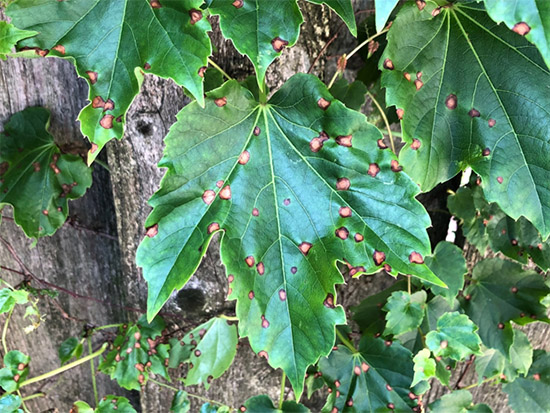Issue 9, June 25, 2018
Guignardia Leaf Spot
Boston ivy and Virginia creeper are two reliable vines that are adaptable to a variety of sites and conditions. Both vines are relatively problem-free. However, Guignardia leaf spot will occasionally blemish their foliage. The pathogen that causes Guignardia leaf spot is closely related to the pathogens that cause black rot of grapes and horse-chestnut leaf blotch.
Guignardia leaf spot causes numerous small, tan to reddish-brown lesions on leaf blades. The lesions are roughly circular, but often appear angular where the spots meet the leaf's veins. Killed tissues within the lesions eventually dries and breaks away from the plant leaving numerous ragged holes. It's not uncommon for all the leaves on the vine to be affected. While the sight of so many leaf spots may be alarming, the damage is mostly aesthetic and won't cause long-term injury to the plant.

Guignardia leaf spot.
In most years, the weather is not favorable for severe disease development. This spring's frequent rain events likely contributed leaf spot outbreaks. Since the pathogen primarily overwinters in diseased leaf litter, one common control measure is to rake, remove, and destroy fallen leaves before budbreak in the spring. However, there is little evidence to show that sanitation will significantly reduce infections. Protective control measures are generally not warranted. Several fungicides are labeled to control the related black rot on grape. However, few products are specifically labeled for guignardia leaf spot on Boston ivy and Virginia creeper. (Travis Cleveland)
Author:
Travis Cleveland